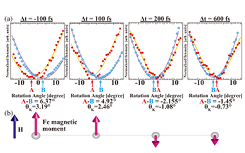Ultrafast Spin-Switching of a FerrimagneticAlloy at Room Temperature Traced by Resonant Magneto-Optical Kerr Effect Using a Seeded Free Electron Laser
I. Matsuda, Wadati, and Shin Groups
Ultrafast spin dynamics in femtosecond timescale, so-called the femtomagnetism, has been one of the central issues in the frontier science and technology for the last two decades. To capture the nature of the non-equilibrium dynamics, ultrafast time-resolved experiments have been carried out using an ultra- short laser pulses. Recently, the developed EUV-X-ray free electron lasers (FEL) and high harmonic generation (HHG) lasers have opened the opportunity for exploring dynamic phenomena with element selectivity by tuning the photon energy of the laser pulses to the absorption edges of a material. Moreover, since the electron exchange interactions, the most fundamental origin of the magnetism, occur in the femtosecond time-scales, ultrafast experiments using FELs and HHG lasers are expected to add the missing knowledge in condensed matter physics that should bring technological innovation in ultrafast spintronics.

Fig. 1. (a) Experimental results (circles) of the intensity variation with rotation angle taken at hv = 53eV for FEL at each delay time shown in each figure with fitting by cosine curve (solid lines). (b) A schematic diagram of the magnetization reversal dynamics of the Fe magnetic moment with respect to an external field H. The length of the arrows is scaled to the magnitude of the Kerr rotation angle at each delay time shown in (a).
One of the famous ultrafast magnetization phenomena is reversal of GdFeCo ferrimagnetic alloy by optical pumping. GdFeCo is known as a ferrimagnetic metallic alloy, composed of rare-earth (RE) and transition metal (TM) sublattices. The two sublattices couple each other anti-ferromagnetically and spin-switching, induced by a femtoseconds-pulse of either circularly or linearly polarized infrared light, has already been reported. However, there is controversy in the suggested dynamical mechanisms and it was proposed recently that the magnetization reversal process is thermal and the reversal can be explained in terms of the angular momentum conservation when the material is irradiated by circular polarized light. More experimental data, in particular using linearly polarized light, are needed to understand the nature of these opto-magnetic phenomena. In the present study, we extended our resonant magneto-optical Kerr effect (RMOKE) technique for FELs to trace the spin in the Fe (TM) site in a GdFeCo crystal.
The experiment was performed at FERMI@ELETTRA in Italy by bring our homemade measurement system to the FEL end-station. The Kerr-rotation angle of RMOKE was determined by rotating-analyzer ellipsomtry (RAE) method and time-resolved measurement was carried out by the pump (Ti:S laser) and probe (seeded FEL) technique. Before optical pumping, a sample was set at room temperature, which is above the magnetic compensation temperature of GdFeCo at 250 K and the external magnetic field was applied in the direction of the initial Fe magnetization. Then, the Fe magnetization reversal was traced in real time by tuning the photon energy (hv = 53 eV) to the Fe M-absorption edge, which added the element-selectively.
Figure 1(a) shows the results of time-resolved measurements. Each panel shows the RAE results at each indicated delay time. The vertical axis denotes the normalized photon intensity. The two curves (blue and red) correspond to the measurements under the applied magnetic field in up and down direction along the sample surface normal. The solid lines are cosine fitting to the experimental results. The angle zero in each panel corresponds to the extinction state without external field. The Kerr rotation angle at each delay time can be extracted from the phase difference between the two curves. The initial Kerr rotation angle was 3.2 degree at -100 fs (before pumping), which was also measured in the static RMOKE (not shown). Since a polar geometry is used in this TR-RMOKE measurement, the Kerr rotation angle indicates the out-of-plane magnetic moment of Fe in GdFeCo. Figure 1(b) schematically depicts the magnetization dynamics with respect to the external field resulting from the time dependent Kerr rotation angle. The length of the arrows in the figure corresponds to the magnitude of the Kerr rotation angle for each delay time. At 200 fs after the intense laser irradiation, changes of sign of the Kerr rotation angle indicate reversal of Fe magnetization. This reversal mechanism is classified in thermal process, being different from the process involving the inverse Faraday effect in the previous studies using circularly polarized light. Considering the FEL repetition rate of 10 Hz at FERMI@ELETTRA the Fe magnetic moment is recovered at least 100 ms after the pump. Since linearly polarized IR pump laser was used there is no coupling in terms of the exchange of angular momentum between photons and spins in the material. This means that the path for angular momentum transfer is closed between the sub-lattices of Gd and Fe. The timescale of magnetization reversal of TM sublattice is the same as observed in preceding research using time-resolved XMCD, in which transient ferromagnetic-like coupling has been observed due to different demagnetization times for RE and TM sublattices. Our measurement of TR-RMOKE reveals its compatibility with FEL for tracing ultrafast spin dynamics.
References
- [1] Sh. Yamamoto et al., Rev. Sci. Instrum. 86, 083901 (2015).
- [2] Sh. Yamamoto et al., Phys. Rev. B 89, 064423 (2014).
